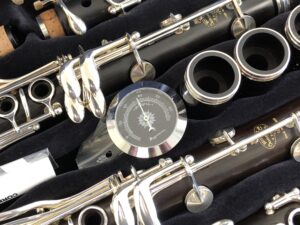
This time of year it becomes a legitimate worry as temperatures fall, forced-air heat systems come on, and humidity plunges. What do we do for our new-instrument inventory? We manage climate, but not too tightly. Here’s why.
First, a quick catch-up on how we think about wood woodwind instruments. Whether we are talking about clarinets, oboes, or wood-bodied piccolos, it is a rough existence. On top of the challenges that a violin or cello face being moved in and out of different microclimates (practice room, car/train, outdoors, stage/pit, rinse and repeat), these instruments spend their operating existence being filled with 98.6 degree damp air, filled with everything you can imagine and more from a player’s mouth.
Dalbergia melanoxylon, or Mpingo, or Grenadilla, or blackwood, or whatever you would like to call it, is tough stuff. But it isn’t bulletproof. Rapid and extreme climate changes and drastic environmental differences can stress the wood to the point of cracking. Blowing that hot, wet air into a cold instrument in a cold room will have the inside and outside of the instrument trying to change shape at different rates — crack city. Playing your instrument in the pit for half a show and then having a well-meaning stage hand open the stage doors at intermission and letting cold air wash across the stage and into the pit — snap, crackle, pop.
For our inventory storage we try to take into consideration the realities of the world outside. Sure, there is probably an optimal temperature and humidity where an instrument will be maximally stable. But, while your storage closet, humidor, or practice room might be regulated, the rest of your playing and traveling environments are not. So, we maintain the instruments within a range, and then drift that range depending on the season.
During the Summer months, we keep instruments between about 70 and 78 degrees F, and around 40 – 48% RH. As we are now transitioning into Winter conditions, we drop that range to roughly 66 – 72 degrees F, and 30 – 38% RH. The idea is to gently settle the instruments into a ballpark close to where they will likely go next so their first experience out of the case after delivery to an artist isn’t an extreme climate shock.
We also have a preferred break-in protocol that we share with clients that, while not a guarantee, we have generally found helps lower the risk of cracks and improves how an instrument breaks in for the long haul.
It comes down to this — however much it is machined and treated, the wood is still a natural material with a complex cellular structure — like you. If you are uncomfortable, your instrument is uncomfortable. If you feel like you experienced an abrupt change of temperature or humidity, rest assured so did your instrument. Store your instrument in a way that respects the basic needs of the material but also minimizes the chance of a shock when you move it or play it.
